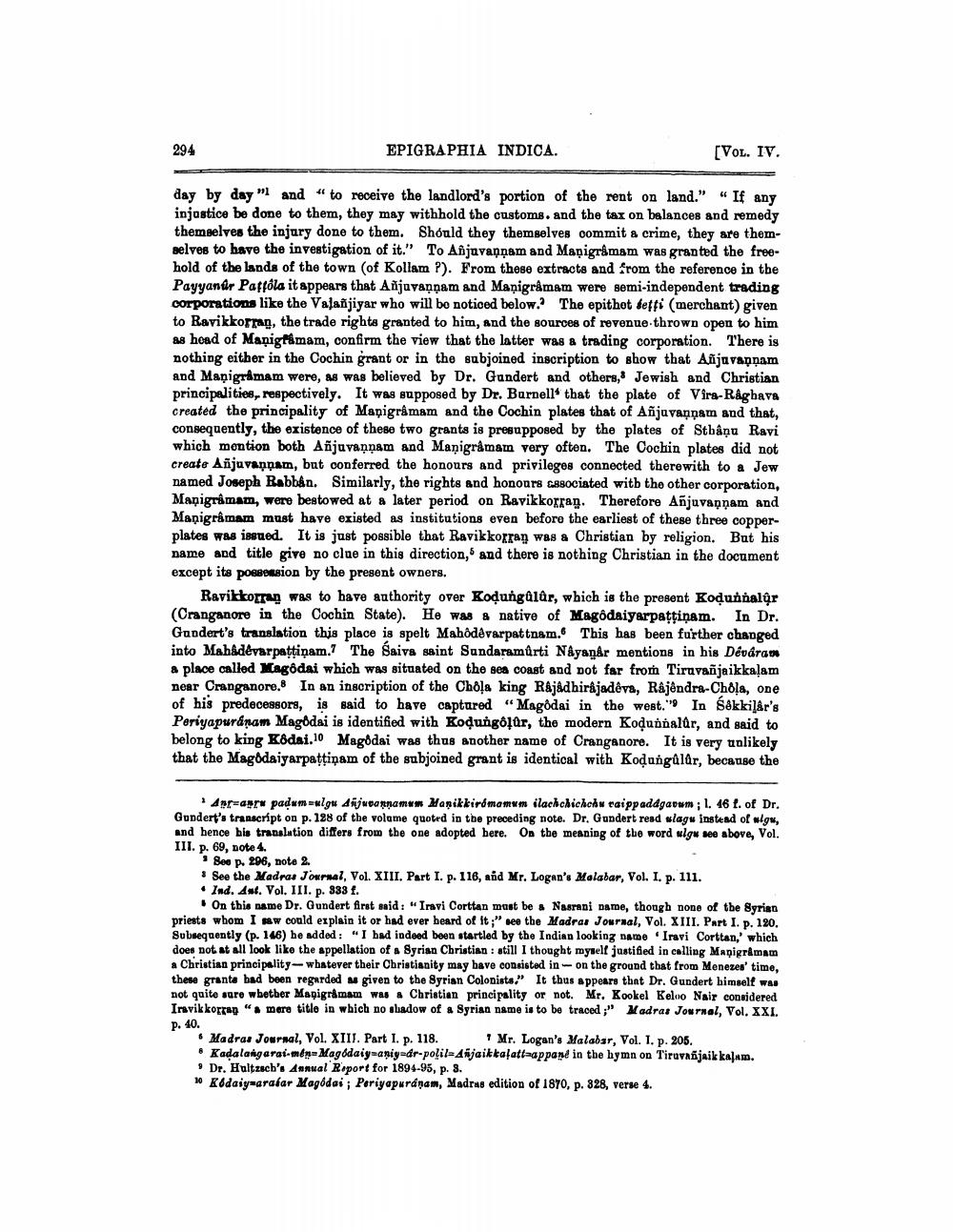________________
294
EPIGRAPHIA INDICA.
(VOL. IV.
day by day" and "to receive the landlord's portion of the rent on land." "If any injustice be done to them, they may withhold the customs. and the tax on balances and remedy themselves the injury done to them. Should they themselves commit a crime, they are themselves to have the investigation of it." To Anjuvannam and Maộigramam was granted the freehold of the lands of the town (of Kollam ?). From these extracts and from the reference in the Payyanur Paffola it appears that Añjavaņņam and Manigråmam were semi-independent trading corporations like the Valañjiyar who will be noticed below. The epithot teffi (merchant) given to Ravikkorrag, the trade rights granted to him, and the sources of revenue thrown open to him as head of Manigtámam, confirm the view that the latter was a trading corporation. There is nothing either in the Cochin grant or in the subjoined inscription to show that Añjavannam and Manigramam were, as was believed by Dr. Gundert and others, Jewish and Christian principalities, respectively. It was supposed by Dr. Barnell* that the plate of Vira-Rågbava created the principality of Manigramam and the Cochin plates that of Añjavaņņam and that, consequently, the existence of these two grants is presupposed by the plates of Sthâņu Ravi which montion both Aõjuvannam and Manigramam very often. The Cochin plates did not create Añjuvannam, but conferred the honours and privileges connected therewith to a Jew named Joseph Rabbân. Similarly, the rights and honours cosociated with the other corporation, Manigramam, were bestowed at a later period on Ravikkorra. Therefore Anjuvaņņam and Manigramam must have existed as institutions even before the earliest of these three copperplates was issued. It is just possible that Ravikkorraŋ was a Christian by religion. But his name and title give no clue in this direction, and there is nothing Christian in the document except its posesion by the present owners.
Ravi korran was to have authority over Kodungalûr, which is the present Kodunnalûr (Cranganore in the Cochin State). He was & native of Magôdaiyarpaţtiņam. In Dr. Gundert's translation this place is spelt Mahôdêvarpattnam. This has been further changed into Mahadevarpattinam. The Saiva saint Sundaramurti Nâyaņár mentions in his Devaran & place called Magódai which was situated on the sea coast and not far from Tiruvañjaikkalam near Cranganore. In an inscription of the Chola king Rajadhirajadêva, Rajendra-Chola, one of his predecessors, is said to have captured "Magôdai in the west." In såkkilar's Periyapuranam Magðdai is identified with Kodungôļur, the modern Kodunnalar, and said to belong to king K8dai.10 Magðdai was thus another name of Cranganore. It is very unlikely that the Magddaiyarpattinam of the subjoined grant is identical with Kodungalar, because the
Aprapre padumuulgu Anjuvannamum Manikkirámamum ilachchichchu raippadagavum ; 1. 46 t. of Dr. Gundert's transcript on p. 128 of the volume quoted in the preceding note. Dr. Gundert read slagw instead of wlgu, and hence his translation differs from the one adopted here. On the meaning of the word wlgu see above, Vol. III. p. 69, Dote 4.
See p. 296, note 2. • See the Madras Journal, Vol. XIII. Part I. p. 116, and Mr. Logan's Malabar, Vol. I. p. 111. • Ind. Asl. Vol. III. p. 338 f.
On this name Dr. Gundert first said: "Iravi Corttan must be a Nasrani name, though none of the Syrian priests whom I w could explain it or had ever beard of it;" see the Madras Journal, Vol. XIII. Part I. p. 120. Subsequently (p. 146) he added: "I had indeed been startled by the Indian looking name Iravi Corttan,' which does not at all look like the appellation of a Syrian Christian : still I thought myself justified in calling Manigrâmam a Christian principality-whatever their Christianity may have consisted in on the ground that from Menezes' time, these granta bad been regarded a given to the Syrian Colonists." It thus appears that Dr. Gundert himself was not quite sure wbether Manigramam was a Christian principality or not. Mr. Kookel Keloo Nair considered Iravik korrap". mere title in which no shadow of a Syrian name is to be traced," Madras Journal, Vol. XXI. P. 40. 6 Madras Journal, Vol. XIII. Part I. p. 118.
Mr. Logan's Malabar, Vol. 1. p. 205. . Kadalangarai-men-Magódaiy-aniydr-polil=Anjaikkal attaappand in the hymn on Tiruvaijaikkalum.
Dr. Hultzsch's Annual Report for 1894-95, p. 3. 10 Kódaiy-arabar Magédai; Poriyapuranam, Madras edition of 1870, p. 828, verse 4.




